FLOWER AND DISCRIPTION OF FLOWERING PLANTS
A flower is a modified shoot and acts as the Site of sexual Reproduction.
The Male and female reproductive organs are borne on flowers.
PARTS OF A FLOWER:
It consists of four whorls – calyx (sepals), corolla (petals), androecium (Male reproductive organ), gynoecium (Female reproductive organs)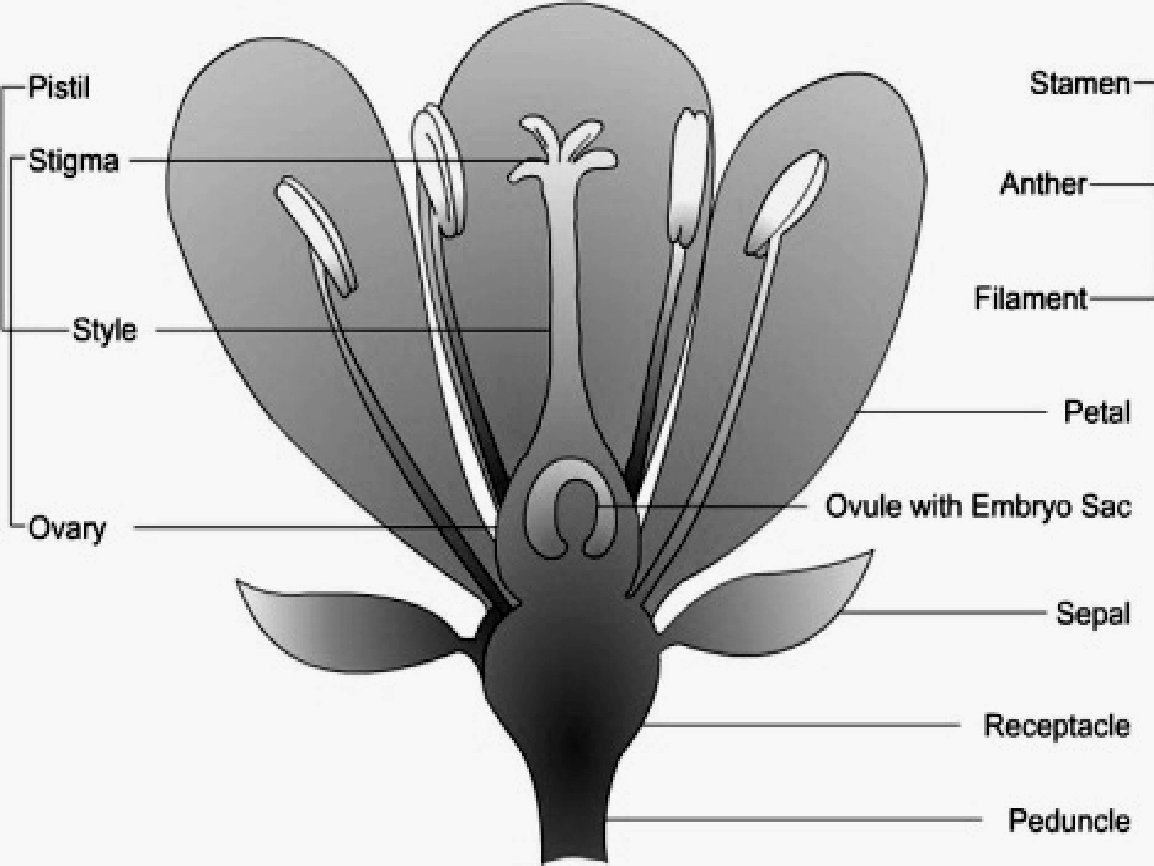
Function of calyx: protects the bud.
Function of corolla: attracts insects by its colour.
Male Reproductive Organ
The male reproductive organ of a flower is called Androecium. Each unit of androecium is called a Stamen.
Each Stamen consists of an anther, filament & connective (when anther is bilobed).
A bilobed anther has 4 Microsporangia (tetrasporangiate).
Female reproduuctive organ
The female reproductive organs of a flower is called gynoecium or pistil. Each unit of gynoecium is called a carpal. Each Carpel consists of a swollen basal part called ovary (the inner wall of ovary is called placenta and it contains ovules), a receptive spot for pollen grains called stigma and a connection between ovary and stigma called style.
TERMINOLOGY RELATED TO A FLOWER;
Complete flower; a flower having all the four whorls.
Incomplete flower; a flower lacking one or more whorls.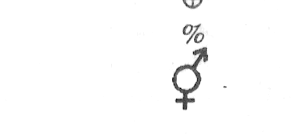
Hermaphrodite-bisexual;- a flower having both sexes present- 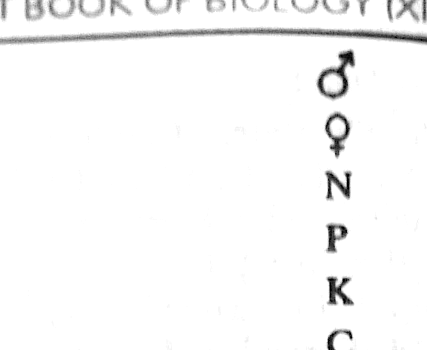
Imperfect-unisexual; a flower lacking any one sex. male or 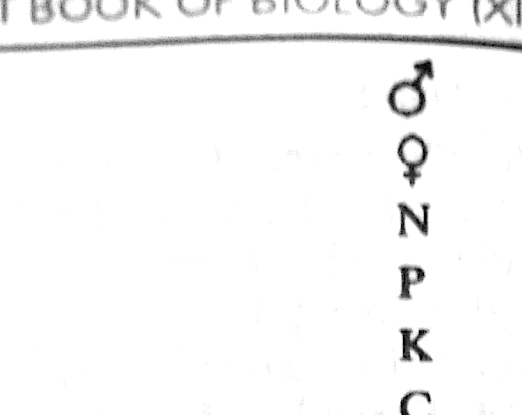
Neuter; a sterile flower.[N]
Polygamous plant; a plant having more than two types of flowers (bisexual, staminate, unisexual))- mango
Monoecious plant;- plants with both sexes (staminate and pistilate flowers)
Dioceous;- a plant bearing only a single sex (either staminate or pistilate).
Floral symmetry;- the shape size and arrangement of floral appendages around the axis of a flower is called floral symmetry.
Based on floral symmetry a flower can be
Actinomorphic;- when a flower can be divided into two equal halves in more than one plane.[⊕]
Zygomorphic; when a flower cannot be divided into two equal halves in more than one plane.[%]
Asymmetric; when a flower cannot be divided into two equal halves in any plane it is called asymmetric.
On the basis of Position of floral parts on thalamus with respect to ovary a flower can be;
Hypogynous;- when all the floral whorls arise from thalamus with ovary situated above them the flower is said to be hypogynous and the ovary is referred to as superior.[G-]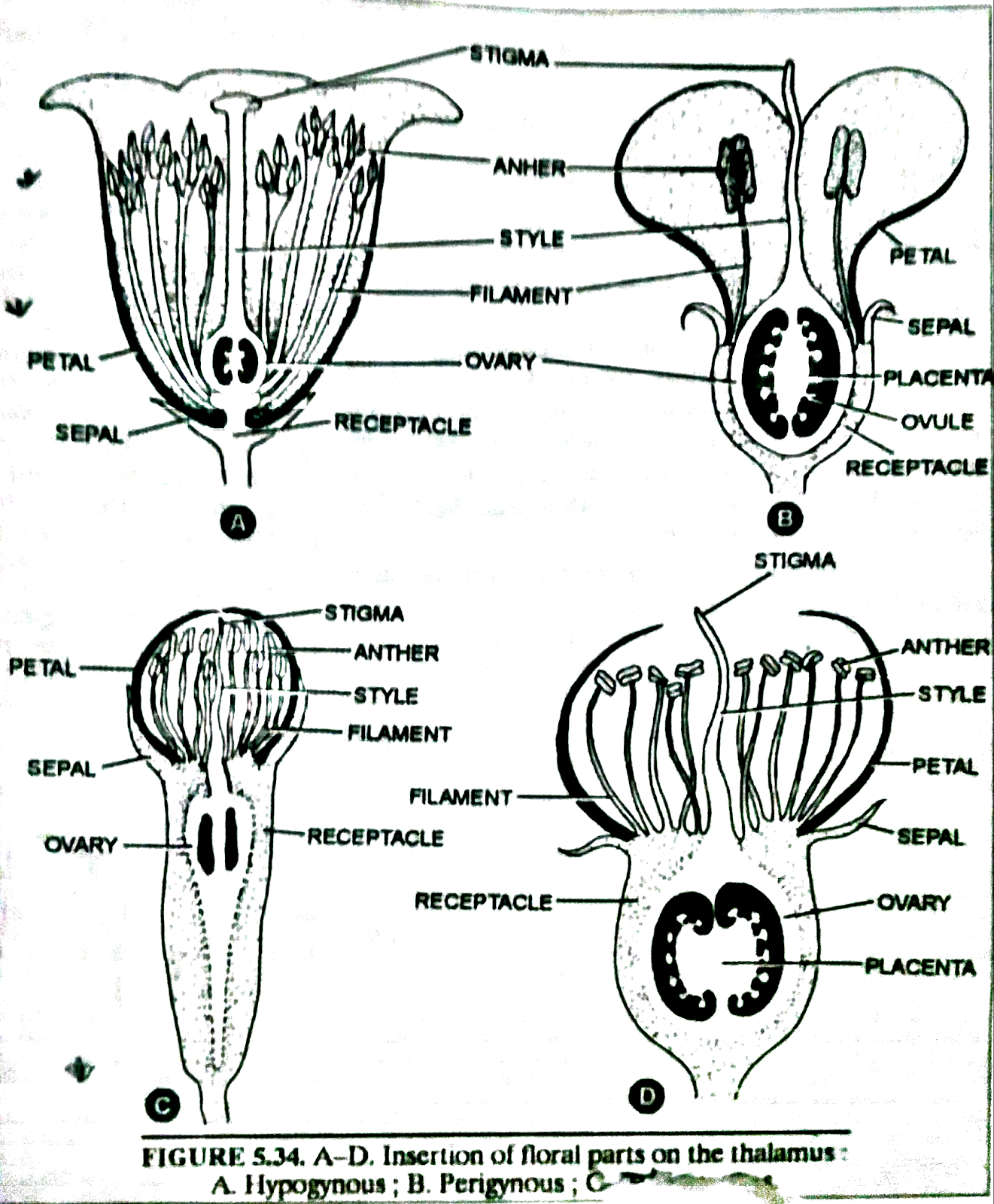
Epigynous;- when ovary is attached directly to thalamus with all other whorls above the ovary (ovary lies below all) the flower is said to be epigynous and ovary is referred to as inferior.[G_]
Perigynous;- when all the whorls arise from the middle periphery of the ovary i.e. ovary neither lies above nor bellow it is said to be perigynous flower and ovary is referred to as semi-inferior [G-].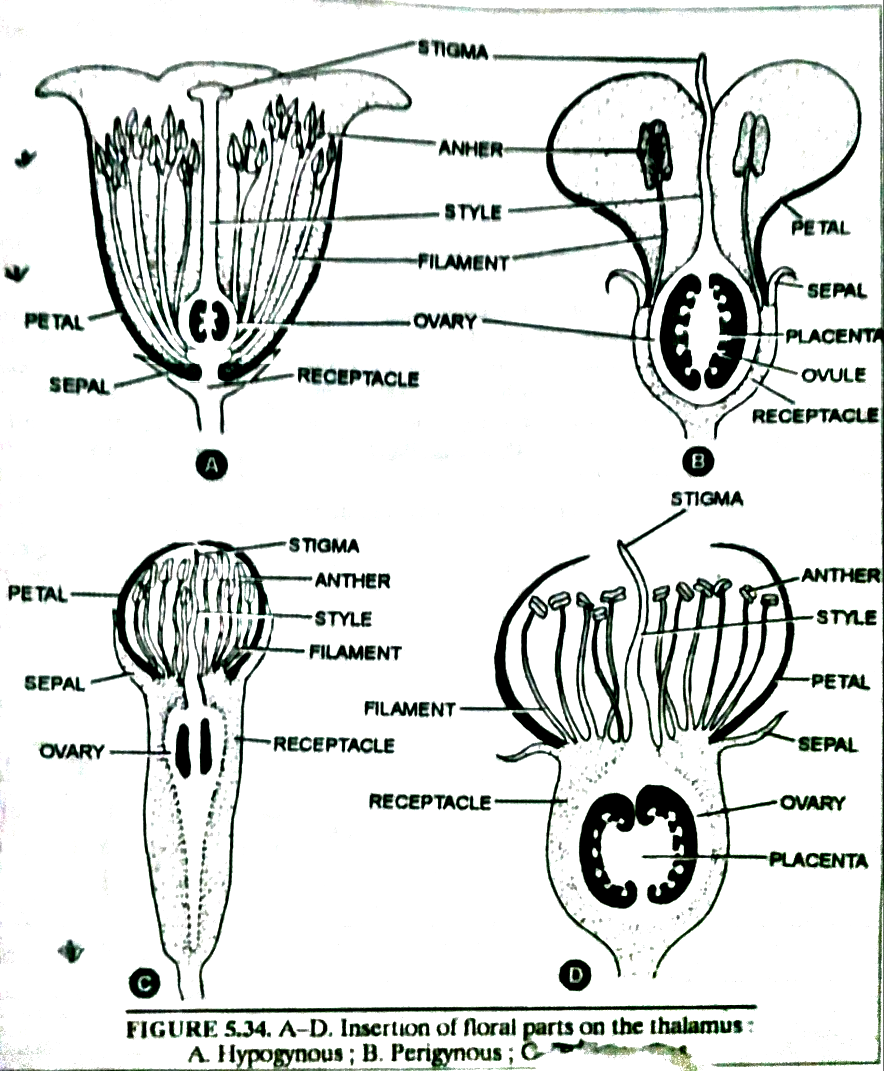
On the basis of no. of floral parts a flower can be;
Dimerous; two floral parts or in multiple of two.
Trimerous; three or multiple of three.
Tetramerous -4, pentamerous -5.
Bracts; bracts are modified leaves which bear flowers in their axils. A flower may be bracteate (bracts present) or ebracteate (bracts absent).
Calyx related terminology [K]
Sepaloid calyx; green in colour like sepals.
Petaloid;- coloured like a petal.
Polysepalous; sepals free and separate. [K1]
Gamosepalous; sepals fused.[K(1)]
Persistent; sepals remain attached till the maturation.
Caducous; Sepals fall off early.
Deciduous; sepals fall off after fertilization.
Terminology related to corolla[C]
Polypetalous; petals are free and separate [C1].
Gamopetalous; Petals are fused [C(1)].
Aestivation;- the mode of arrangement of petals in relation to one another is called aestivation. It is of following types;
Open; when petals of a whorl are apart from each other.
Valvate; petals of a whorl meet by their edges but do not overlap.
Twisted;- margin of one petal overlaps with other petal and that is in turn overlapped by other.
Imbricate; Here out of five petals one lies external one internal and remaining three are twisted.
Ascending imbricate; here the posterior petal lies internal.
Descending imbricate or vexillary;. Here anterior petal lies internal.
Quincunical;- out of five petals two lie external one internal and two twisted.
Parianth; when sepals and petals are same and cannot be distinguished the whorl is said to be parianth and each unit of parianth is called a tepal.
Terminology related to androecium;[A]
Monoadelphous; all stamens are united in one bundle.
Diadelphous; stamens are united in two bundles.
Polyadelphous; stamens arranged in more than two bundles.
Syngenesious; when anthers are united to form a cylinder with filaments free.
Synandrous; anthers as well as filaments are fused into a bundle.
Polyandrous; stamens are indefinite and free.
Gynandrous; stamens fused with ovary.
Epipetalous; stamens fused to petals by their filaments.
Epitepelous; stamens fused to tepals. 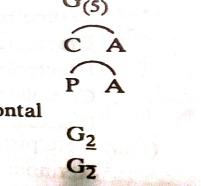
Didynamous; two long and two short stamens.
Tetradynamous; four long and four short stamens.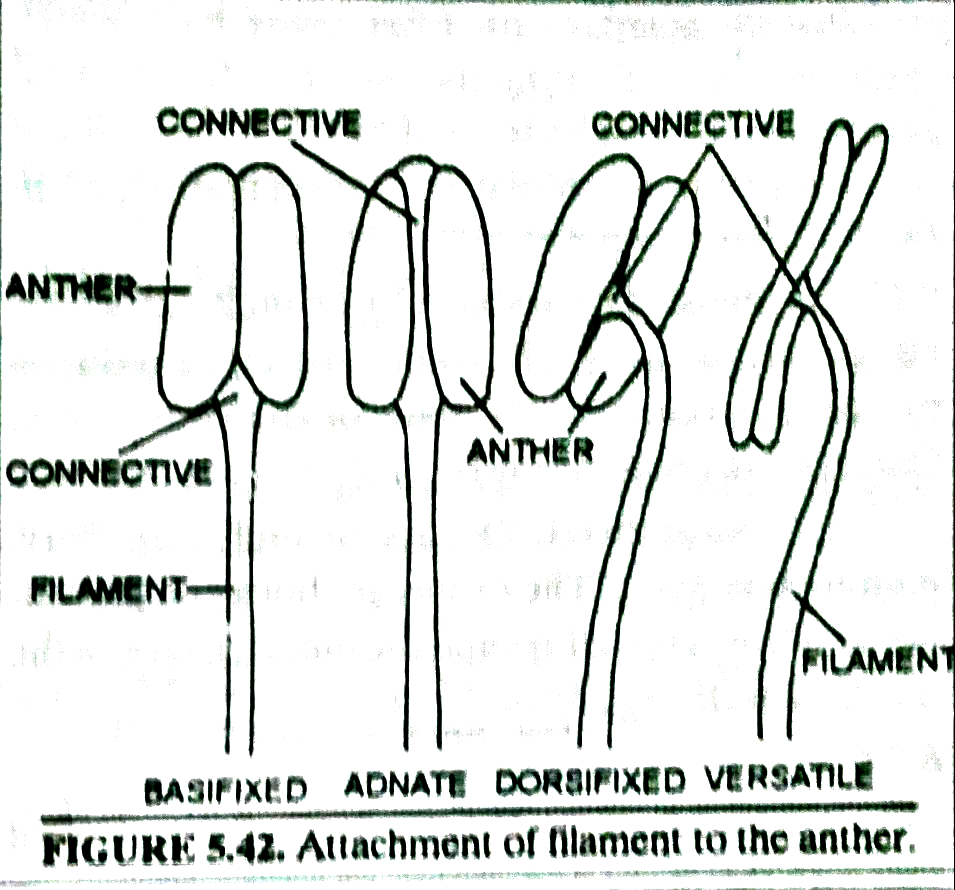
ANTHERS
Dithecous anthers; anthers having two lobes.
Monothecous; anthers having only one lobe.
Basifixed anthers; filament attached to an anther at base.
Adnate; filament attached along the length.
Dorsifixed;- filament attached to dorsal side.
Versatile; tapering filament attached from back side.
Terminology related to gynoecium[G]
Monocarpellary; consists of a single carpal.
Bicarpellary; consists of two carpel’s.
Multicarpellary; consists of many carpel’s
Apocarpous; carpels free.
Syncarpous; carpels fused
As per the no. of locules are concerned an ovary can be unilocular i.e. ovary with one chamber, bilocular, trilocular and multilocular.
Placentation; the way an ovule in an ovary is attached to placenta is called Placentation. it is of following types.
Marginal; ovules attached along the margin-pea.
Axile; occurs in multilocular ovary. Here the ovules are attached to the placenta at the center in each locule-hibiscus
Parietal; occurs in unilocular ovary. The ovules are attached to the placenta at ridges present in groups. -argemone
Free central; here the placenta forms an up growth in the centre of ovary and ovules are attached to it.
Basal; here the ovules are reduced to one and attached to the placenta at base.
Superficial;- here the placenta forms the partition walls and ovules are attached to it all along there length.
FLORAL FORMULA; floral formula is the summarized account of floral characters of a plant or family represented by symbols. The symbols for different characters are given with the each character described above.
FLORAL DIAGRAM;- a diagrammatic representation of the collected information from transverse section of flower bud in relation to mother axis is called as floral diagram.
The mother axis in a floral diagram is shown by a small circle on posterior side.
A bract is drawn as a single arc on anterior side.
Calyx is drawn as a whorl of arcs (solid) representing number of sepals.
Corolla is drawn inner to calyx as a whorl of arcs representing petals. Fused petals are represented by fused arcs and free with free arcs.
Stamens are drawn in the shape of kidney inner to corolla in spiral arrangement. Fused kidneys with solid line indicate fused stamens.
Gynoecium is drawn in the centre. Apocarpous condition is shown by drawing a number of separate circles, syncarpous by fused circles.
SEED
The seed is a developed ovule. Development of the fertilized ovule into the mature seed involves several different parts. From the outside to inwards these are as follows:
- The zygote develops into an embryo.
- The integuments of the ovule become the seed coat of the mature seed. This sometimes consists of two distinct coverings, a typically firm outer coat, the testa, and a generally thin, membranous inner coat, the tegmen.
- The nucellus may persist in some genera as a thin layer - the perisperm
- The endosperm accumulates reserves of food and its fullest development is rich in carbohydrates, fats, proteins and growth
- The funiculus forms the stalk of the seed. Hilum marks the point of attachment to the stalk
- Micropyle remains as a pore on the surface of seed
Structure of Dicot and Monocot Seeds
Structure of Dicot non-endospermic seed (bean seed):
The seeds of bean like those of other legumes are formed within the pod, which is a ripened ovary. The seed is attached to the inside of the pod by the funiculus or seed stalk. When the seeds are shed, the funiculus breaks off, leaving a prominent scar, the hilum. Just below the hilum can be seen the micropyle and above the hilum is the ridge formed by the raphe. The bean seed has two seed coats outer testa and inner tegmen. Each seed encloses an embryo. The bulk of embryo consists of large cotyledons which stores Most of the food of seed. On the side of the seed, opposite the raphe at the micropylar end the cotyledons form cotyledonary node. Attached to it is found the radical. Plumule has differentiated two well-defined leaves which fold over the growing tip. These become the first true leaves of the bean plant on germination. The portion between radical and cotyledonary node is called hypocotyl. The portion between plumule and hypocotyl is called epicotyls. In this seed and in all seeds of this type, there is no endosperm, this tissue is already consumed by the developing embryo. 
Structure of Monocot, endospermic grain (maize grain ):
It is one seeded fruit called caryopsis or grain because pericarp (fruit wall) is fused with testa. Seed coat is the outer brownish layer of the grain. In this, seed and fruit walls are fused together. Endosperm comprises the major part of grain and is filled with reserve food. It is composed of two regions Outer single layered aleurone layer mainly made up of aleurone proteins. Inner starchy endosperm. It is separated from embryo by a layer called epithelium. Embryo contains a single lateral cotyledon called scutellum and embryo axis with plumule and radicle at its two ends. Root cap protects the tip of radicle. Radicle is surrounded by a protective sheath called coleorhiza. Plumule is also protected by a covered sheath known as coleoptile.
FRUIT
A true fruit is formed as a result of cell division expansion and differentiation in the ovary wall (placenta). The ovary is transformed into fruit as a result of stimuli received from pollination and developing seeds. The wall of ovary develops into pericarp of the fruit that is differentiated into epicarp, mesocarp, and endocarp. During pollination the pollen grains release auxin that induces the fruit development.
STRUCTURE OF FRUIT 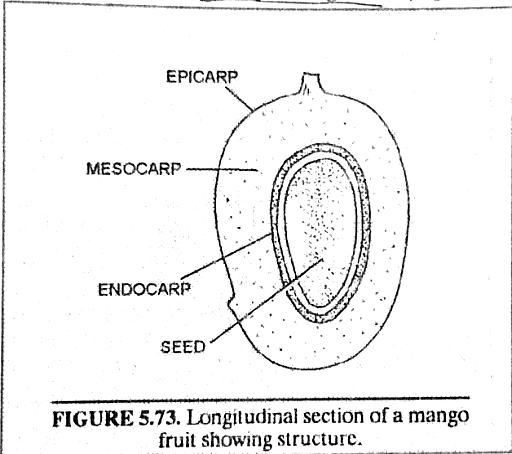
A true fruit consists of two main parts the seed and the pericarp (fruit flesh). The pericarp consists of three layers- upper epicarp, middle mesocarp and inner endocarp.
TYPES OF FRUITS
Fruits are of three main types
1-SIMPLE FRUITS;
the fruits that develop from a single monocarpellary or multicarpellary syncarpous ovary are called simple fruits. These are further of two types:
A-dry simple fruits; these fruits have dry pericarp not differentiated into three layers. these are further of three types.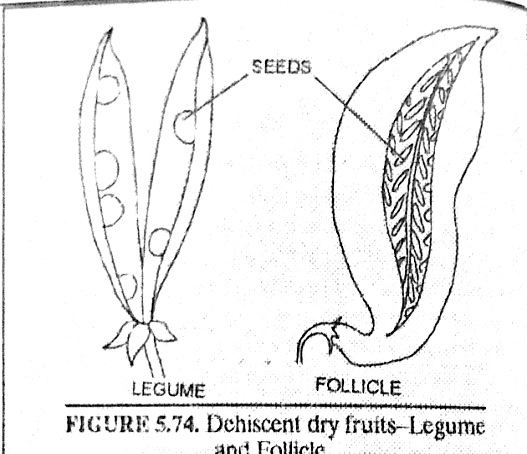
(i)-Dehiscent dry fruits;
Legume; a fruit developed from a monocapellary superior ovary which dehisces from both the sutures into two halves -pea
Follicle;- which dehisces from one suture only -calotropis
Siliqua; develop from a bicapellary superior ovary with a replum or false septum. Dehisces along two sutures -brassica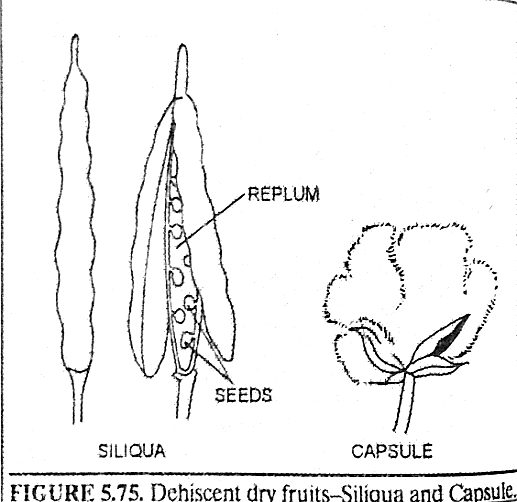
Capsule; dehiscent dry fruit which dehisces along more than two suture in different planes.
(ii)-Schizocarpic dry fruits
Lomentum; a legume like fruit that dehisces transversely into one seeded indehiscent compartments -tamarindus
Cremocarp; develops from an inferior ovary, splits longitudinally into two indehiscent halves called mericarps -cariandrum sativum.
Regma; it breaks into as many segments as there are carpels -ricinus.
Carcerule; here it breaks into four indehiscent parts with one seed per locule-ocimum.
(iii)Indehiscent dry fruits
Achene; a small indehiscent one seeded fruit with a hard and leathery pericarp that remains free from seed coat -mirabilis jalapa.
Caryopsis; small indehiscent one seeded fruit with a hard and leathery pericarp fused with seed coat - wheat, rice
Cypsela; a one seeded fruit that develops from a multicarpellary ovary with persistent calyx - tridex 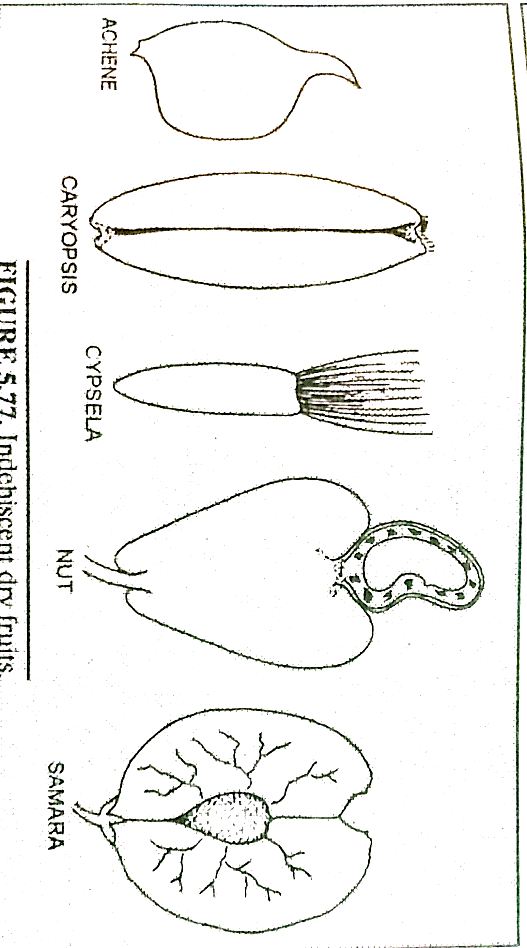
Nut; large indehiscent one seeded fruit with a hard and stony fruit wall - chesnut.
Samara; a dry indehiscent one seeded fruit in which pericarp is modified into wings- chilbil.
B-Fleshy simple fruits; fruits with fleshy pericarp distinguished into epicarp mesocarp and endocarp;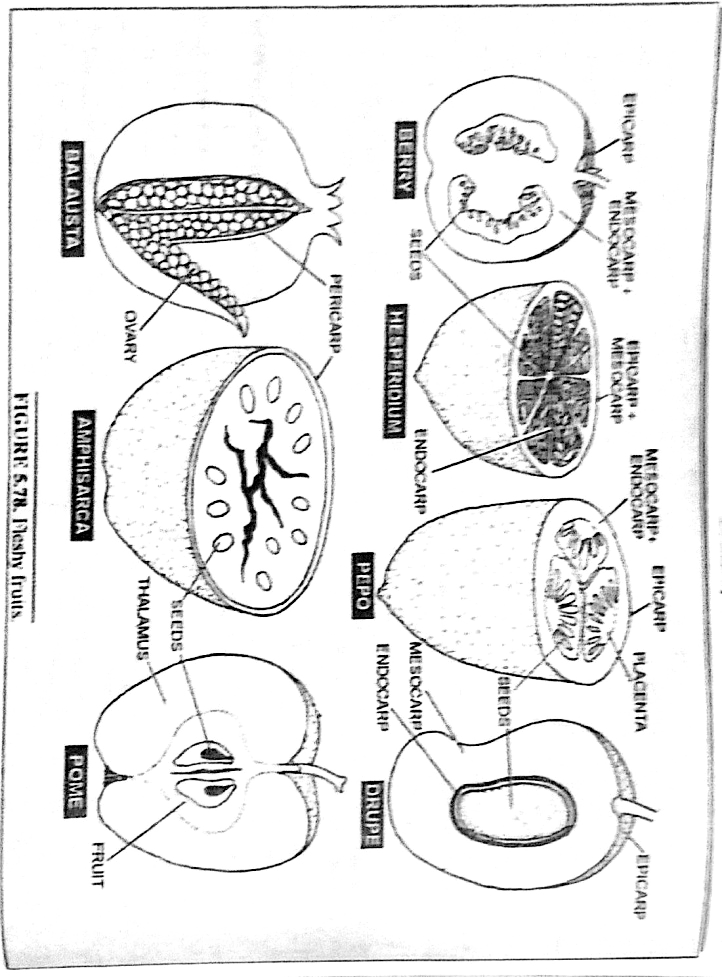
Berry; a fleshy many seeded fruit with massive juicy and pulpy pericarp-tomato grapes.
Hesperidium; a fleshy many seeded fruit with a firm hard and leathery pericarp- citrus, lemon, orange
Pepo; a large fleshy fruit with pulpy pericarp -melon, cucumber
Drupe;- a fleshy one seeded fruit with the inner hard stony pericarp enclosing a seed-mango, wall nut, peach, cherry.
Balausta; a fleshy fruit with many chambers and many seeds -pomegranate
Amphisarca; a fleshy fruit with woody pericarp and edible placenta- wood apple
Pome; a false fruit that develops from thalamus with true fruits inside containing seeds-apple pear etc
2-AGGREGATE FRUITS
Fruit developed from multicarpellary apocarpous ovary; comprised of many fruitlets;
Etaerio of follicles; fruit consisting of many follicles arranged on thalamus-calotropis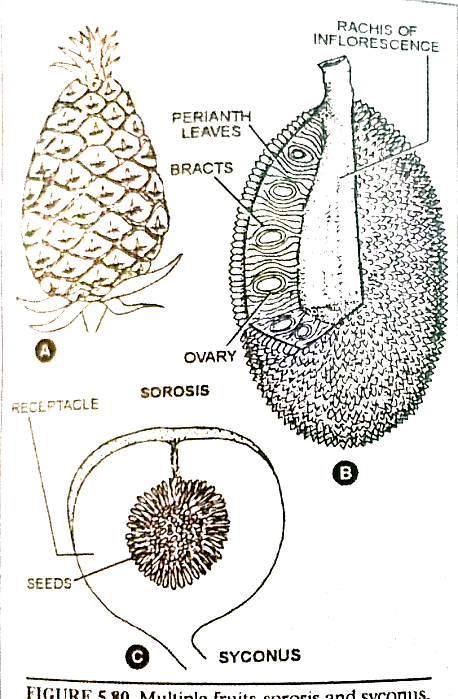
Etaero of achenes; an aggregate of achenes -strawberry
Etaerio of drupes; an aggregate of drupes- rasberry
Etaerio of berries; an aggregate of berries -anona squamosa
MULTIPLE OR COMPOSITE FRUITS;
the fruits that develop from the complete inflorescence;
Sorosis; fruit developed from a spike or spadix inflorescence - pine apple, mulberry
Syconus; fruit developed from Hypanthodium inflorescence - ficus.



No comments:
Post a Comment